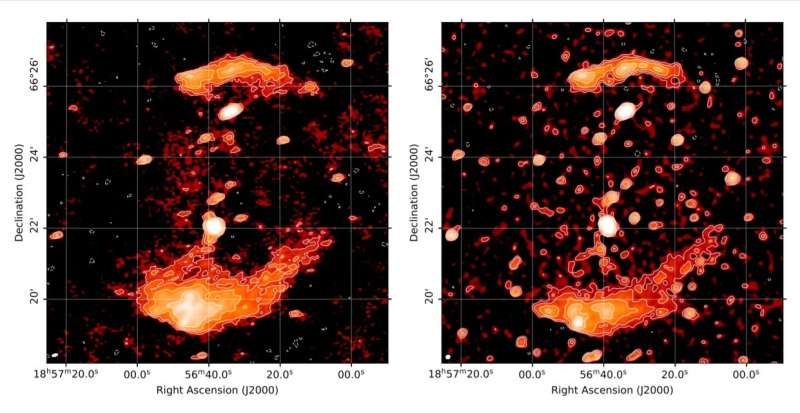June 2, 2021 report
Astronomers inspect radio relics in galaxy cluster PSZ2 G096.88+24.18

An international team of astronomers has performed radio and X-ray observations of radio relics in a merging galaxy cluster known as PSZ2 G096.88+24.18. Results of this monitoring campaign could shed more light on the nature of this galaxy cluster. The study was published May 18 on arXiv.org.
Radio relics are diffuse, elongated radio sources of synchrotron origin. They occur in the form of spectacular single or double symmetric arcs at the peripheries of galaxy clusters. Astronomers are especially interested in studying such sources in merging galaxy clusters, as the number of radio relics associated with merger shocks is still small.
At a redshift of 0.3, PSZ2 G096.88+24.18 (also known as ZwCL1856.8+6616) is a low-mass (around 470 trillion solar masses) merging galaxy cluster system. Previous observations of this cluster with the Westerbork Synthesis Radio Telescope (WSRT) at 1.4 GHz detected a pair of radio relics on its northern and southern edges.
A team of astronomers led by Alexander Jones of the University of Hamburg, Germany, has now investigated in detail the double radio relic in PSZ2 G096.88+24.18. For this purpose, they conducted radio observations of this cluster using the Karl G. Jansky Very Large Array (VLA) and the Low Frequency Array (LOFAR), as well as an X-ray study of this system with NASA's Chandra spacecraft.
"In this paper we present LOFAR HBA (140 MHz) and VLA (1.5 GHz) radio observations and X-ray Chandra data of PSZ2 G096.88+24.18. With these multi-frequency observations we carry out spectral and polarization analysis of the double radio relics in PSZ2 G096.88+24.18," the researchers wrote in the paper.
The study found that the two diametrically opposed radio relics of PSZ2 G096.88+24.18 are approximately equidistant from the cluster center, about 3.58 and 3.26 million light years for the northern and southern relics respectively. At 140 MHz these two sources have largest linear sizes of some 2.93 and 4.89 million light years and a flux ratio of 1:3.5 for the north and south relics respectively.
Radio observations have revealed the presence of a patch of diffuse emission (dubbed Connection by the authors of the paper) connecting one radio galaxy designated S1 with the southern relic. The Connection coincides with a region in the radio relic in which an increase in surface brightness has been observed. The detected large patch of diffuse emission is likely affecting the properties of the relic.
Trying to find the most plausible explanation for the Connection, the astronomers assume that it is most likely a merger shock wave which has passed over an active galactic nucleus (AGN) lobe.
"The integrated spectral index steepens along the Connection, away from S1, which appears to suggest re-acceleration of an AGN lobe (...) Recent simulations by ZuHone et al. (2020) show that a merger-driven shock wave passing through the jets of an AGN can produce an inhomogeneous cosmic ray fraction along the major axis of a shock. If this is the case in PSZ2 G096.88+24.18, this may explain the observed radio surface brightness discontinuity and therefore suggest that the east and west sides of the southern relic are generated by the same acceleration mechanism," the researchers concluded.
More information: Radio relics in PSZ2 G096.88+24.18: A connection with pre-existing plasma, arXiv:2105.11906 [astro-ph.HE] arxiv.org/abs/2105.11906
© 2021 Science X Network




















